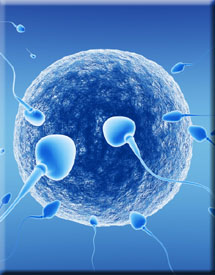Fertility - infertility
 Fertility dysfunction in men and women can have multiple physiological and psychological reasons. Clinical studies show that one of the main reasons of infertility is reduced tissue blood perfusion (ischemia) and consequent low tissue oxygenation or hypoxia. These two mechanisms are interconnected and can be result of a history of infections, inflammations or miscarriages.
Fertility dysfunction in men and women can have multiple physiological and psychological reasons. Clinical studies show that one of the main reasons of infertility is reduced tissue blood perfusion (ischemia) and consequent low tissue oxygenation or hypoxia. These two mechanisms are interconnected and can be result of a history of infections, inflammations or miscarriages.
Males with fertility issues often have subclinical prostate dysfunction again resulting in low sperm count and impaired sperm cell formation as a consequence of microcirculatory dysfunction and hypoxia.
Hyperbaric Oxygenation (HBO) provides an enormous natural asset in treatment of infertility:
- Hyperbaric oxygen oxygenates all organs and promotes the growth of microcirculation
- Hyperbaric oxygen specifically enhances fibroblast migration, mitosis and induces collagen synthesis which directly promotes and ripens the tissue for fertility
- Hyperbaric oxygen acts as natural antibiotic and increases the body’s ability to suppress chronic underlying opportunistic infections including bacteria and viral based DNA infections (Chlamydia, Mycoplasma, Herpes virus, etc)
- Hyperbaric oxygen significantly enhances white blood cell (WBC) function of phagocytosys. Elevated oxygen levels increase the oxygen free radicals and hydrogen peroxide formation in the white cell lysosomes, improving antimicrobial activity.
- Hyperbaric oxygen promotes healing and facilitates the effects of additional immune stimulating programs including herbs and other nutritional regimes.
- Hyperbaric oxygen enhances immune capabilities, enabling greater wound healing, infection control, and alleviation of tissue ischemia.
- Hyperbaric oxygen reduces painful inflammation and swelling
- Hyperbaric oxygen reinstates normal lymphatic drainage,
- Selected prescribed medications and immune stimulating vitamins are enhanced with increased tissue oxygenation
- Hyperbaric oxgyen facilitates elimination of toxins and metabolic by products from the body which is greatly increased in patients with inadequate fertility responses
- Hyperbaric oxygen increases male genital microcirculation, thus improving the spermatic morphological and functional characteristics as well as spermatogenesis.
Typically patients receive a baseline treatment of between 40-60 hours of hyperbaric oxygen therapy (HBOT) in conjunction with appropriate immune-stimulating injections. Patients with complex pelvic dysfunction, post-surgical scarring including abdominal and spinal-related typically require considerably higher frequencies of hyperbaric oxygen to penetrate the deeper structures. Generally post-operative patients require between 80-100 hours and or greater to changes tissue substrates and revascularize the target region. These individuals generally require pre- and post-ultrasound and often MRI to evaluate hyperbaric oxygen changes.
Further reading:
- Mitrović A, Nikolić B, Dragojević S, Brkić P, Ljubić A, Jovanović T. Hyperbaric oxygenation as a possible therapy of choice for infertility treatment Bosn J Basic Med Sci. 2006 May; 6(2):21-4.
- Zadoev SA, Evdokimov VV, Rumiantsev VB, Osmolovskii EO. Hyperbaric oxygenation in the treatment of patients with chronic congestive prostatitis and lower fertility, Urologiia. Jan-Feb;(1):27-30, 2001.
- Leverment J, Turner R, Bowman M, Cooke CJ. Report of the use of hyperbaric oxygen therapy (HBO2) in an unusual case of secondary infertility; Undersea Hyperb Med. Summer;31(2):245-50, 2004.
- Zhyla VV, Danyliuk IuO, Hulei IaT, Andrusyk VI, Maksimenko VS. Restoration of reproductive ability in patients with chronic prostatitis. Klin Khir. ;(2):51, 1998.
- Van Voorhis BJ, Greensmith JE, Dokras A, Sparks AE, Simmons ST, Syrop CH. Hyperbaric oxygen and ovarian follicular stimulation for in vitro fertilization: a pilot study. Fertil Steril, 2005 Jan;83(1):226-8.
- Asribekova MK, Karpova SK, Murashko LE, Sidel’nikova VM, Malysheva VA, Proshina IV. State of the sex hormone receptor in the endometrium of women with late habitual abortion – hyperbaric may assist. Probl Endokrinol (Mosk). 1991 Jan-Feb; 37(1):26-8.
